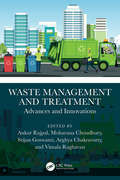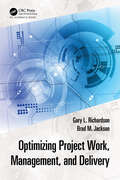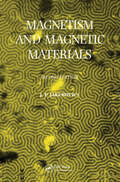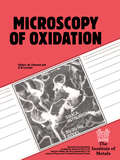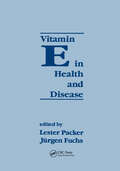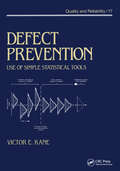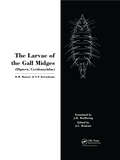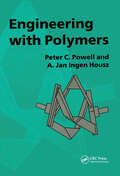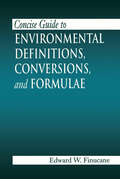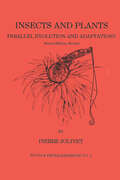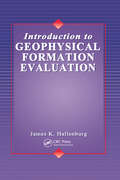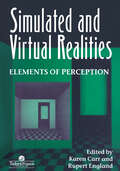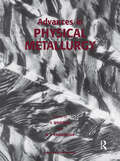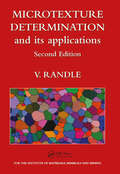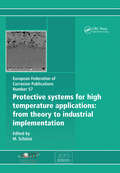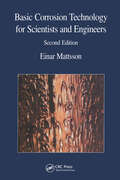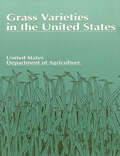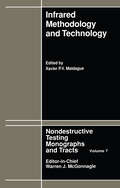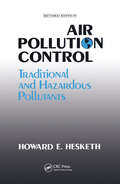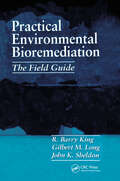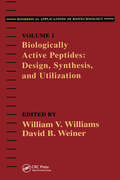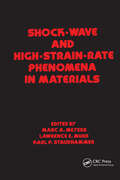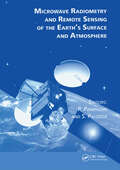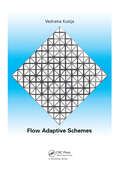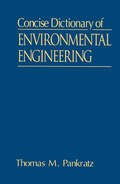- Table View
- List View
Waste Management and Treatment: Advances and Innovations
by Srijan Goswami Moharana Choudhury Arghya Chakravorty Ankur Rajpal Vimala RaghavanThis book covers environmental and economic waste treatment with resource recovery strategies covering mining, urban, agricultural, industrial, and sewage wastes. It includes waste management, life-cycle assessment, recycling, and recovering valuable materials from blast furnace slags, iron ore, coal, and bauxite mining. Wastewater recycling, reuse, treatment methods, and economic gain through nanotechnology are covered, along with biochemical study cycles in mining waste and tailing, landfill stabilization, energy, and nutrient recovery from household, urban, and hazardous waste.Features: Includes details on the generation and composition of hazardous wastes Focuses on practices in waste management followed in developing countries Illustrates the concept of energy and resource recovery Explains ethical, innovative management strategies dealing with solid, biomedical, and chemical wastes Discusses sustainable nanotechnology and engineered materials for treatment of biological and chemical pollutants in wastewater This book is aimed at researchers and graduate students in environmental engineering and management.
Optimizing Project Work, Management, and Delivery
by Gary L. Richardson Brad M. JacksonThousands of project management–related books have been written. Why is Optimizing Project Work, Management, and Delivery different? This book represents the authors’ experiences gained from looking at the problem of project management for 50 years and wondering why projects cannot be more successful. Experience from various management models and techniques has helped but still does not fit reality or provide accurate forecasts. Industry surveys have compiled the root causes of project failure, and yet they persist. Is there no answer to this problem? As the book explains, the management solution is not in the models or the theory but is found in how they are mapped against the actual target project characteristics. This is the book’s unique strength. There are major coverage gaps in current project management models that also need to be recognized. All of the existing models are correct in some ways, and yet each is also wrong. The book starts by reviewing popular models and related topics that help construct the building blocks of an integrated model structure, which is at the core of this book. The integrated model described here is meant to be a decision-oriented view related to the project life cycle rather than a cookbook of success steps. Project management is too complex for a cookbook approach. This text helps managers find that right path.
Magnetism and Magnetic Materials
by J.P. JakubovicsMagnetic materials have many interesting and important uses. This book discusses the subject of magnetism and magnetic materials at a level suitable for undergraduates studying Materials Science, Physics or Engineering. It gives a brief introduction to the fundamental ideas in magnetism, and then explains the classification of materials
Microscopy of Oxidation
by G.W. LorimerMicroscopy of Oxidation: the proceedings of the Second International Conference Held at Selwyn College, University of Cambridge, in 1991.
Vitamin E in Health and Disease: Biochemistry and Clinical Applications
by Lester PackerProbes developments and trends in research and clinical applications of vitamin E, discussing its chemistry and biochemistry and natural occurence in nuts, seeds, whole grains and vegetable and fish-liver oils. The book covers new findings on the role of vitamin E as a biological response modifier.
Defect Prevention: Use of Simple Statistical Tools
by 0 Kane,This book discusses statistical process control (SPC) concepts, emphasizing the need to establish stability of work processes. It gives the elements required to develop a defect prevention system (DPS), and integrates the application of process control and problem analysis tools.
The Larvae of the Gall Miges
by B.M. Mamaev N.P. KrivosheinaThe characteristics of all main groups of soil-bound insects are given in this book.
Engineering with Polymers, 2nd Edition
by P. C. Powell A. J. Ingen HouszPlastics and rubber materials, or polymers, are increasingly the first choice of engineers when reliable, cost-effective performance and safety are essential. The volume of polymers used in the Western economy now exceeds that of metals, which requires today's engineering students to have a thorough grounding in the properties and applications of polymeric materials. The first chapters of Engineering with Polymers explain what polymers are, how they behave, and how articles are made from them. The authors then show how the standard engineering techniques of stress analysis, structures, fluid mechanics, heat transfer and design can be adopted or adapted to cover plastics and rubber materials. The book ends with chapters detailing interactions between processing and properties, and a description of a variety of approaches to designing plastics products, from practical advice to the use or further development of theoretical principles, backed up by examples and case studies. The book is aimed at mechanical engineering students and design engineers in industry and also at materials' and chemical engineers.
Concise Guide to Environmental Definitions, Conversions, and Formulae
by Edward W. FinucaneAs occupational health and safety professionals require increased awareness of the whole field-and not just its specialized areas-they've started to need an all-encompassing reference work of necessary mathematical relationships.Concise Guide to Environmental Definitions, Conversions, and Formulae is the quick and proficient source for that information. Professionals will find it's ideal for immediate reference; students and interns can benefit from it as a comprehensive study guide for certification exam preparation purposes.Based on information presented in another essential reference (Definitions, Conversions, and Calculations for Occupational Safety and Health Professionals, Second Edition), the Concise Guide brings its most-cited details to an easily carried, portable size (41/2 x 6 3/4). Essential conversions, formulae, and definitions all await within those pages.Virtually all of the mathematical relationships, formulas, definitions, and conversion factors any health and safety expert or trainee will ever need are all contained in the Concise Guide to Environmental Definitions, Conversions, and Formulae.
Insects and Plants: Parallel Evolution & Adaptations, Second Edition
by Pierre JolivetInsects and plants, whether or not they coevolved, have intimate interrelationships. This book concisely yet thoroughly describes these phenomena. In one chapter the salient facts known about carnivorous plants are described. In another, ant and plant relationships are summarized as an introduction to this vast subject. Pollination, of great interest to agriculturists and horticulturists, is briefly explained without the complexities detailed in the massive literature on this topic. Many other subjects are discussed, such as the memory of adult butterflies, which enables them to return to their host plants in the case of the polyphagous species. The book is seeded with such thought-provoking discussions as prostitution among the orchids and botanical indigestion in some plants.
Introduction to Geophysical Formation Evaluation
by James K. HallenburgThese three works cover the entire field of formation evaluation, from basic concepts and theories, through standard methods used by the petroleum industry, on to new and exciting applications in environmental science and engineering, hydrogeology, and other fields. Designed to be used individually or as a set, these volumes represent the first comprehensive assessment of all exploration methodologies. No other books offer the breadth of information and range of applications available in this set.The first volume, Introduction to Geophysical Formation Evaluation, is the perfect introductory reference for environmental professionals without previous training in the field. It explains the fundamentals of geophysical exploration and analysis, illuminates the underlying theories, and offers practical guidance on how to use the available methodologies. General information on material behavior, porosity, tortuosity, permeability, cores, resistivity, radioactivity, and more provides a solid foundation for more advanced studies.The second volume, Standard Methods of Geophysical Formation Evaluation builds on the basic precepts presented in the first work but can be used alone as a self-contained reference. It covers all the petroleum-oriented standard methods which, until recently, have comprised the majority of applications of geophysical formation evaluation. It also points out non-hydrocarbon uses of petroleum methods. This volume provides complete practical information and instructions on using the standard exploration and evaluation methods. It presents comprehensive, painstakingly detailed instructions for resistivity, radiation, and acoustic methods.The third volume, Non-Hydrocarbon Methods of Geophysical Formation Evaluation, discusses uses of formation evaluation in environmental science and engineering, hydrogeology, and other fields outside the petroleum industry, and demonstrates how the standard methods can be adapted to these non-hydrocarbon purpos
Simulated And Virtual Realities: Elements Of Perception
by Karen CarrVirtual reality is a perceptual experience, achieved using technology. Anyone wishing to develop virtual reality should understand the human perceptual processes with which the technology seeks to interact and control. The book presents state-of-the-art reviews of the current understanding of these human perceptual processes and the implications for virtual reality. It reports research which has tried to make the technology capable of delivering the required perceptual experience, comprising a basis for future virtual reality research, so as to achieve the optimum development of the field. It is intended to be of use to anyone who is involved with the creation of a virtual reality experience.
Advances in Physical Metallurgy
by Anirban BanerjeeThis volume focuses on the wealth of existing literature on physical metallurgy, and deals with materials in different states of order and the process of order evolution. It is a valuable reference by students and researchers in the field of materials science and metallurgy.
Microtexture Determination and Its Applications
by V. RandleA cornerstone in the study of both natural and technological materials is characterisation of microstructure. In the widest sense this topic encompasses, for all phases present: morphology, including size and shape distributions; chemical composition; crystallographic parameters, including orientation and orientation relationships. A landmark advance for the materials community occurred with the genesis of 'microtexture', which for the first time provided integration of crystallographic parameters and other aspects of the microstructure. A definition of microtexture is: 'a population of crystallographic orientations whose individual components are linked to their location within the microstructure.' The term microtexture also describes any experimental technique used to determine this information. Essentially, a stationary beam of electrons is diffracted by atomic planes in the sampled volume of specimen. Analysis of the resulting diffraction pattern provides crystallographic information which can be related back to its position of origin. An estimated 95 percent of microtexture determination is by 'electron backscatter diffraction' (EBSD) in a scanning electron microscope (SEM), with the remaining 5 percent contributed mainly by transmission electron microscopy (TEM) counterparts to EBSD. Evaluation (indexing) of EBSD diffraction patterns and output of data in a variety of formats is in most cases fully automated. The most exciting EBSD output is an 'orientation map', which is a quantitative depiction of the microstructure in terms of its orientation constituents. Microtexture determination is now firmly established as the most comprehensive experimental tool for quantitative characterisation and analysis of microstructure, and is used extensively in both research and industry. Much has changed since this book was first published and the second edition has been completely rewritten to reflect these changes.
Protective Systems for High Temperature Applications EFC 57: From Theory to Industrial Implementation
by M. SchutzeThis book is a review of corrosion and thermal protection topics associated with coatings applied in high temperature applications, namely catalytic converters, combustion and steam environments, and gas turbines. Information on corrosion influencing mechanisms and their impact are reviewed.
Basic Corrosion Technology for Scientists and Engineers
by Einar MattssonAn introductory guide covering Basic Corrosion Technology for Scientists and Engineers first published in 1999.
Grass Varieties in the United States
by U.S. Dept. of AgricultureThis user-friendly handbook is a working guide to the status of named and experimental grasses available for use in the United States. It provides physical descriptions and status profiles of grass varieties, including turf grass varieties. The handbook also contains maps and descriptions of Land Resources Regions and Plant Hardiness Zones that assist in the understanding of plant adaptation areas. Whenever available, the information in the handbook includes:
Infrared Methodology and Technology
by Xavier P.V. MaldaqueFocuses on the growth and potential uses of infrared thermography as a nondestructive testing and monitoring technique. Part 1 of this monograph is an introduction to current infrared NDT theory and technology; Part 2 describes the wide range of infrared NDT and monitoring applications.
Air Pollution Control: Traditional Hazardous Pollutants, Revised Edition
by Howard D. HeskethSince the first edition was printed in 1991, there have only been minor changes in air regulations. The opposing "trenches" used by environmental regulation proponents have deepened as each side increases their database. Agencies and environmental groups have backed off a little in issues such as bubble policies and enforcement time tables. This has made it extremely difficult for equipment vendors to anticipate industry requirements. Overall, the current market projections are not very favorable for the new equipment suppliers. In contrast, the service organizations are seeing increasing need for their help in areas such as dispersion modeling, troubleshooting and testing. Existing systems are being improved upon to keep them in operation. There remains a continuous need for up-to-date references and training materials to serve these needs, and it is for this purpose this revised edition is dedicated.
Practical Environmental Bioremediation: The Field Guide, Second Edition
by R. Barry King John K. Sheldon Gilbert M. LongBioremediation, or enhanced microbiological treatment, of environments contaminated with a variety of organic and inorganic compounds is one of the most effective innovative technologies to come around this century! Practical Environmental Bioremediation: The Field Guide presents updated material, case histories and many instructive illustrations to reflect the evolving image of this fast-emerging industry. Bioremediation technology has witnessed great strides towards simplifying treatability formats, finding new approaches to field application, more potent nutrient formulations, monitoring protocols and the resulting general improvement in results. This new guide condenses all current available knowledge and presents necessary technical aspects and concepts in language that can be readily comprehended by the technical student, experienced scientist or engineer, the aspiring newcomer, or anyone else interested in this exciting natural cleanup technique.
Biologically Active Peptides: Design, Synthesis and Utilization
by David B. Weiner William V. WilliamsInvestigation into basic and advanced peptide design, synthesis, evaluation and utilization. New therapeutic approaches from experimental systems.
Shock Wave and High-Strain-Rate Phenomena in Materials
by 0 Meyers,These proceedings of EXPLOMET 90, the International Conference on the Materials Effects of Shock-Wave and High-Strain-Rate Phenomena, held August 1990, in La Jolla, California, represent a global and up-to-date appraisal of this field. Contributions (more than 100) deal with high-strain-rate deforma
Microwave Radiometry and Remote Sensing of the Earth's Surface and Atmosphere
by P. Pampaloni S. PalosciaThis book contains a selection of refereed papers presented at the 6 Specialist Meeting on Microwave Radiometry and Remote Sensing of the Environment held in Florence, Italy on March 15-18, 1999. Over the last two decades, passive microwave remote sensing has made considerable progress, and has achieved significant results in the study of the Earth's surface and atmosphere. Many years of observations with ground-based and satellite-borne sensors have made an important contribution to improving our knowledge of many geophysical processes of the Earth's environment and of global changes. The evolution in microwave radiometers aboard satellites has increased steadily over recent years. At the same time, many investigations have been carried out both to improve the algorithms for the retrieval of geophysical parameters and to develop new technologies. The book is divided into four main sections: three of these are devoted to the observation of the Earth's surface and atmosphere, and the fourth, to future missions and new technologies. The first section deals with the study of sea and land surfaces, and reports recent advances in remote sensing of ocean wind, sea ice, soil moisture and vegetation biomass, including electromagnetic modelling and the assimilation of radiometric data in models of land surface processes. The following two sections are devoted to the measurement of atmospheric quantities which are of fundamental importance in climatology and meteorology, and, since they influence radio-wave propagation, they also impact on several other fields, including geodesy, navigational satellite and radioastronomy. The last section presents an overview of new technologies and plans for future missions.
Flow Adaptive Schemes
by Vendrana KutijaA study in the development of flow adaptive numerical schemes in computational hydraulics directed to enhancing modelling capabilities. Examples covered include additional flow resistance due to flexible vegetation; one-dimensional supercritical flow; and flow in networks of channels.
Concise Dictionary of Environmental Engineering
by Thomas M. PankratzConcise Dictionary of Environmental Engineering contains thousands of definitions of terms used in the field of environmental engineering, including technical terms, abbreviations, and product/process trademarks and brand names. It helps you make sense out of technical reports and papers, and makes finding the right word for your own reports and papers easy!
